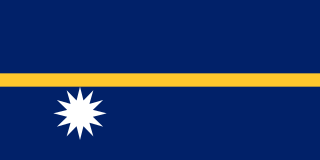
Nauru, officially the Republic of Nauru and formerly known as Pleasant Island, is an island country and microstate in Oceania, in the Central Pacific. Its nearest neighbour is Banaba Island in Kiribati, 300 km (190 mi) to the east. It further lies northwest of Tuvalu, 1,300 km (810 mi) northeast of the Solomon Islands, east-northeast of Papua New Guinea, southeast of the Federated States of Micronesia and south of the Marshall Islands. With only a 21 km2 (8.1 sq mi) area, Nauru is the third-smallest country in the world behind Vatican City and Monaco, making it the smallest republic. Additionally, its population of 10,670 is the world's second smallest, after Vatican City.

The history of human activity in Nauru, an island country in the Pacific Ocean, began roughly 3,000 years ago when 12 Micronesian and Polynesian clans settled the island.
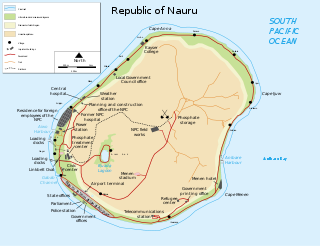
Nauru is a tiny phosphate rock island nation located in the South Pacific Ocean south of the Marshall Islands in Oceania. It is only 53 kilometres (33 mi) south of the Equator at coordinates 0°32′S166°55′E. Nauru is one of the three great phosphate rock islands in the Pacific Ocean—the others are Banaba in Kiribati and Makatea in French Polynesia.

Yaren, is a district of the Pacific nation of Nauru. It is the de facto capital of Nauru and is coextensive with Yaren Constituency.
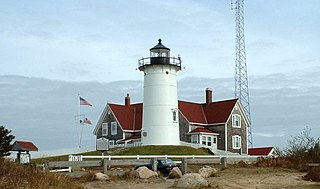
Falmouth is a town in Barnstable County, Massachusetts, United States; Barnstable County is coextensive with Cape Cod. The population was 31,532 at the 2010 census, making Falmouth the second-largest municipality on Cape Cod after Barnstable. The terminal for the Steamship Authority ferries to Martha's Vineyard is located in the village of Woods Hole in Falmouth. Woods Hole also contains several scientific organizations such as the Woods Hole Oceanographic Institution (WHOI), the Marine Biological Laboratory (MBL), the Woods Hole Research Center, NOAA's Woods Hole Science Aquarium, and the scientific institutions' various museums.

Occidental Mindoro is a province in the Philippines located in the Mimaropa region. The province occupies the western half of the island of Mindoro. Its capital is Mamburao, but the largest municipality is San Jose. As of 2015, Occidental Mindoro has 487,414 inhabitants.

Anibare is a district in the island nation Nauru, a part of the Anabar Constituency.

Boe is a district in the country of Nauru. It is the only district of Boe Constituency.
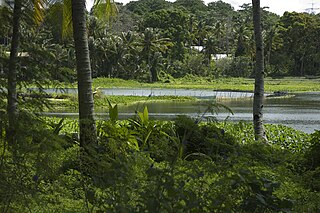
Buada is a district in the Pacific nation of Nauru. It is the only district in Buada Constituency. It has a population of 739 (2011).

Ubenide is one of the constituencies of Nauru and is made up of the four districts: Baitsi, Denigomodu, Nibok, and Uaboe. It covers an area of 4.5 km², and has a population of 3,300. It returns four members to the Parliament of Nauru in Yaren.
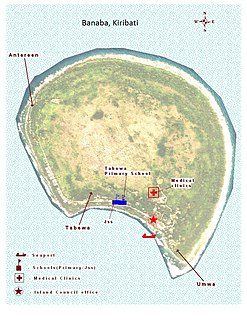
Banaba is an island of Kiribati in the Pacific Ocean. A solitary raised coral island west of the Gilbert Island chain, it is the westernmost point of Kiribati, lying 185 miles (298 km) east of Nauru, which is also its nearest neighbor. It has an area of 6.0 km2, and the highest point on the island is also the highest point in Kiribati, at 81 metres (266 ft) high. Along with Nauru and Makatea, it is one of the important elevated phosphate-rich islands of the Pacific.

The Kai Islands of Indonesia are a group of islands in the southeastern part of the Maluku Islands, located in the province of Maluku. The Moluccas have been known as the Spice Islands due to regionally specific plants such as nutmeg, mace, and cloves that originally intrigued the European nations of the 16th century.

The Bubi people are a Bantu ethnic group of Central Africa who are indigenous to Bioko Island, Equatorial Guinea. Once the majority group in the region, the population experienced a sharp decline due to war and disease during Portuguese expeditions. By the end of Spanish colonial rule in the mid 20th century, and after substantial intermarriage with newly introduced populations, such as Afro-Cubans, Krio people, Portuguese people and Spaniards, the Bubi people, again, experienced a great decline in number. Seventy-five percent perished due to tribal/clan rooted political genocide during a civil war that led to Spanish Guinea's independence from Spain. This, too, sparked mass exodus from their homeland with most of the exiles and refugees immigrating into Spain. The indigenous Bubi of Bioko Island have since co-existed with non-indigenous Krio Fernandinos; and members of the Fang ethnic group, who have immigrated in large numbers from Río Muni. Once numbering approximately 3 million, the Bubi currently number around 100,000 worldwide.
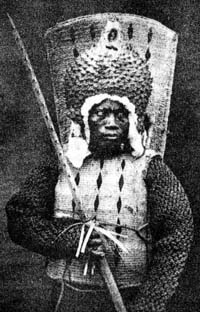
The Nauruan Civil War was fought from 1878 to 1888, between forces loyal to incumbent King Aweida of Nauru and those seeking to depose him in favour of a rival claimant. The war was preceded by the introduction of firearms to Nauru. For the majority of the war, the loyalists and the rebels found themselves in a stalemate, with one side controlling the north and the other controlling the south. In 1888, the German Empire intervened by restoring Aweida to the throne, and by taking combatants' firearms. Over the course of the war, Nauru had lost around 500 people, a third of the pre-war population.

Tailevu is one of the 14 provinces of Fiji. One of eight provinces based in Viti Levu, Fiji's largest island, its 755 square kilometers occupy the south-eastern fringe of the island, along with some central areas. At the 2017 census, it had a population of 64,552, the fifth largest among the Provinces. The main urban area of Tailevu is Nausori with a population of 21,645 in 1996.

Buada Lagoon is a landlocked, slightly brackish, freshwater lake of Buada District in the island nation of Nauru. It occupies about 0.05 square miles (0.13 km2).

Banguingui, also known as Sama Banguingui or Samal Banguingui is a distinct ethno-linguistic group native to the Balanguingui Islands but also dispersed throughout the Greater Sulu Archipelago and southern and western coastal regions of the Zamboanga Peninsula in Mindanao, Philippines. They are one of the ethnic groups usually collectively known as the Sama-Bajau peoples.

Nauru is positioned in the Nauru Basin of the Pacific Ocean, on a part of the Pacific Plate that formed at a mid oceanic ridge at 132 Ma. From mid Eocene (35 Ma) to Oligocene times a submarine volcano built up over a hotspot, and formed a seamount composed of basalt. The seamount rises over 4300 m above the ocean floor. This hotspot developed simultaneously with a major Pacific Plate reorganisation.

The following outline is provided as an overview of and topical guide to Nauru:
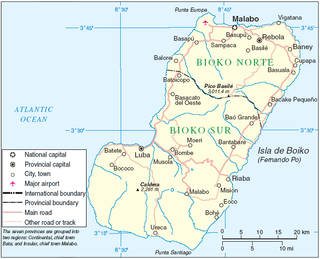
Bioko is an island 32 km (20 mi) off the west coast of Africa and the northernmost part of Equatorial Guinea. Its population was 335,048 at the 2015 census and it covers an area of 2,017 km2 (779 sq mi). The island is located off the Ambazonian segment of Cameroon, in the Bight of Bonny portion of the Gulf of Guinea. Its geology is volcanic; its highest peak is Pico Basile at 3,012 m (9,882 ft).


















